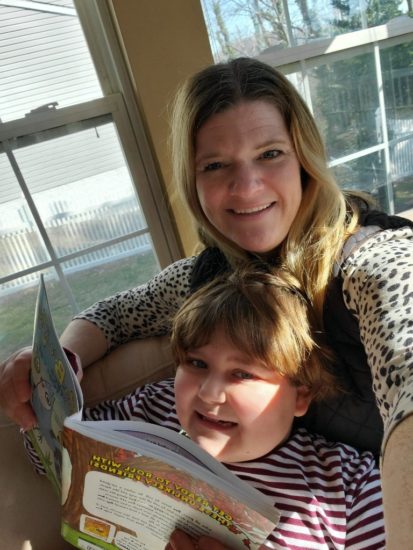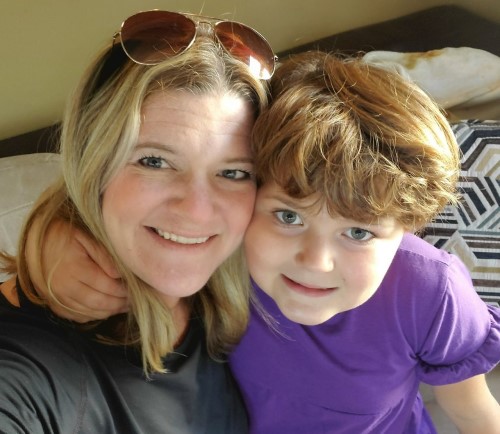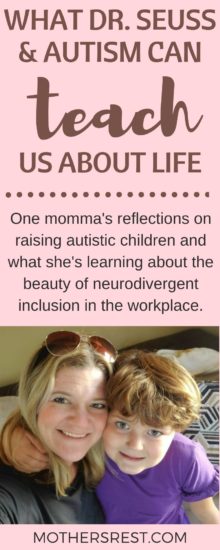By Stephanie Ranno, guest blogger
Just like listening to a recording of your own voice, re-reading this post I wrote in 2018 kinda makes me cringe.
What about you? What comes up for you when you read it? Especially if you have an autistic or neurodivergent child.
What Dr. Seuss and autism can teach us about life
The Cat in the Hat, The Lorax, Sam I Am, The Sneetches, The Grinch are well loved Dr. Seuss personalities in The Ranno household. With three book-loving children, we have spent eight years enjoying the rhythms, delighting in the whimsical stories, and taking away important lessons on creativity and acceptance from Dr. Seuss’ works.
Currently, The Cat in The Hat is on heavy rotation in our home, with my daughter reciting pages by heart night after night. Anyone with a person in their life on the autism spectrum knows the equal parts comfort and mind-numbing annoyance of this repetition.
As I ease into the 35th night in a row reading about Sally, the Boy, the Cat, the Fish, and Thing One and Thing Two, I still find joy reading the words, listening to the lilting rhythm, and observing my daughter point out things I’ve missed in prior readings.
Since her diagnosis three years ago, and I expect throughout the rest of my life, I will vacillate between acceptance and the desire to change my daughter.
I work in the world of recruiting and staffing. Daily, I give career advice, review resumes, and talk to hiring managers about “ideal” candidates. One thing I know that’s 100% stacked against my daughter and other people on the spectrum is the social and nonverbal communication skills required to land a job and move into positions of success.
I accept her gifts and limitations. I accept a possible different “future of success” for her. But I still hope, as any parent does, that she finds meaningful work and relationships. That she, and the world, continue to change for the positive.
Dr. Seuss and my daughter see and express ideas in different, wonderful, and perplexing ways. Dr. Seuss creates whole worlds and people of fantastical color, uniqueness, and diversity. My daughter speaks in scripts, discovers patterns on a hike through the forest, and points out the parts of a picture or scene that are lost on most of us. Like the bird in the tree being rained upon in the opening of The Cat in the Hat.
How often could all of us “neurotypicals” out in the “real world” use a different set of eyes, a unique approach, a creative way of thinking to help us improve what we’re doing?
In the last few years, leaders from more than 50 companies, including SAP, Microsoft, JP Morgan, and Ford, have come together at the Autism at Work Summit to share ideas, strategies, and hope for inclusion of adults on the autism spectrum at work. These companies see an untapped population of thinkers and workers who can help them. To solve problems. To achieve goals. To delight customers.
This is great news. Especially given the fact that the number of unemployed people on the spectrum is depressingly high at 75%.
Each year, one in 44 children in the US are diagnosed on the autism spectrum. So it’s going to take more than a few large companies employing a couple hundred neurodiverse people to make a significant impact and create that “future of success” for my daughter.
It’ll take a doggedly persistent, “Sam I Am” effort. Do you know he was rejected 69 times?!
It’ll take each one of us in our own places of work – and out in the community – to act.
It’ll take, to quote The Lorax, “Someone like YOU – to care a whole awful lot, or nothing is going to get better. It’s not.”
And just think of all the vibrant colors and insight my daughter can bring into your world. Leading you to discover things you never imagined possible. Like green eggs and ham.
Reflecting on this in 2022
I wrote that piece for SparkVisionNow.com back in March 2018.
Now, I see my own ableist perspective. It’s in phrases like, “I will vacillate between acceptance and the desire to change my daughter,” and the overarching premise that autism is here to “teach us” about life and inspire us in some sorta way.
Four years after writing this, my biggest take-away is that I need to keep learning and seeking to understand from those who are autistic. That my parenting, managing, business consulting, and hiring practices should be bettered not by what I need but for what others need.
These days, I learn not only from my daughter, but from my older son – diagnosed in 2021 at age 11.5 – and from the talented #actuallyautistic adult community on LinkedIn and other neurodivergent leaders who share their expertise and lived experience.
Two of my favorite phrases that run on repeat in my mind are:
“If you’ve met one person with autism, you’ve met one person with autism.”
–Dr. Stephen Shore, autistic professor and self-advocate
“Nothing about us, without us” — a rallying mantra for both autistic self-advocates and the greater disability community
I keep these quotes front and center when I share, write, speak, or act in support of autistic and neurodivergent inclusion in the workplace.
I’m grateful for people, like Ginny at MothersRest, who have been incredibly supportive of my posts and perspective and who have given me a platform to share with other special needs working parents who may be on a similar journey of learning and growth.
At least Dr. Seuss was right about one thing. So says Horton: “I’ll stay and be faithful” – and keep on learning. Every day.
And again I ask you, dear reader:
What comes up for you when you read my journey? Especially if you have an autistic or neurodivergent child.
Share your thoughts below or on Facebook at MothersRest.
About the guest blogger:
Stephanie Ranno is Vice President of Business Development and Account Management for TorchLight Hire, where she helps marketing leaders build talented teams and grow purposeful, progressive careers. She regularly appears on podcasts and webinars and guest blogs sharing her perspective on staffing, inclusion, and neurodiversity in the workforce.
A wife and mother of three, Stephanie believes a woman can have it all – a meaningful career, a healthy family, and fulfilling engagement in creative and community projects – just maybe not all at the EXACT same time.


